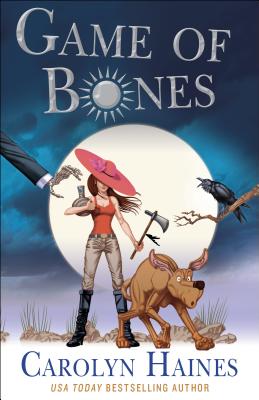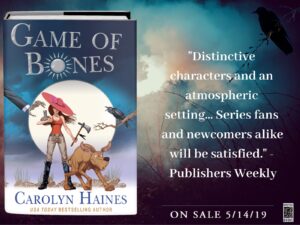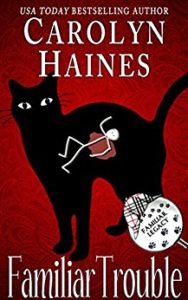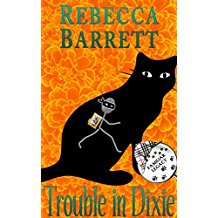Hey, y’all! I’m so excited to have writer Carolyn Haines visit with us. Decades ago, even before Carolyn started her mystery series featuring Sarah Booth Delaney, I saw several of her books shelved in a place of honor at a friend’s house. My friend told me that Carolyn was a wonderful writer, and as an unpublished newbie, I immediately got stars in my eyes knowing I was thatclose to a famous writer. Carolyn’s writing is truly wonderful, and these days, I’m proud to call her my own good friend.
(If you’re in the Houston area, dash over to the amazing MURDER BY THE BOOK for a signing event with Carolyn, plus Terry Shames, TONIGHT at 6:30 p.m.)
Carolyn is here to talk about the pleasures and pitfalls of having a successful, long-running series. Please give her a warm TKZ welcome!
LONG LIVE THE BONES
I’ve been writing about my amateur detective Sarah Booth Delaney for over 20 years—and I have 20 books documenting her mystery-solving skills. The latest, GAME OF BONES, was just released. But I have to tell you, it’s my time to whine. In the world of Zinnia, Mississippi, Sarah Booth Delaney seldom ages. In the twenty years I’ve been writing about her and the rest of the gang, Sarah Booth has aged less than two years. I, on the other hand, have stacked two decades onto my total orbits around the sun. This is not fair.
While Sarah Booth remains eternally young, still able to consider pregnancy (though she is pushing that really hard as her personal “haint” Jitty would tell her) and still able to perform the physical feats that make her a good detective (and also a bit like Lucille Ball), I am feeling the passage of the years in my bones. Sarah Booth has never met trouble she didn’t want to get down and wallow in. I have not been arrested in a while, so I’m a slacker.
I’ve read a lot of blogs from authors who talk about “when it’s time to end a series.” To be perfectly honest, when I wrote THEM BONES, I didn’t realize I was writing a series. The book sold at auction and the publisher who bought it wanted a 3-book deal. I was terrified. I’ve always read mysteries, but I never considered myself a skilled plotter. But there I was—with two additional mysteries to write, and then two more, and then two more, and then three, etc., etc.
Now, the characters are so much a part of my daily life that it’s hard to imagine NOT writing about them. They are family, and I love the work of bringing their adventures to the page.
Over the course of two decades, I’ve outlined the series arc. I know what the last book in the series will be, but since I just signed another three-book contract, it won’t be until after 2022. (There will be two books in 2021. One in May, my regular publication time, and a special Christmas book.)
Through the years, folks have pressured me to marry Sarah Booth off and let her have young-uns. I’ve resisted this pressure for a number of reasons. First and foremost, Sarah Booth doesn’t listen to me or to Jitty, her ancestral ghost who tries to boss her around for her own good. I tried to edge Sarah Booth toward more romance with one character, but she balked completely. She knows her own mind. As I said, she is like family and the Haines clan is known to be hard-headed. My guidance is often rejected. But again, that makes the stories interesting to write.
Aside from Sarah Booth’s recalcitrant behavior, there are other reasons. I’ve read a lot of series books and watched a lot of series television where the two leading characters finally give in to lust, love, or domesticity. That’s the point I lose interest in the characters. I realize not all people are like me, but as the writer, I refuse to spend time in a world that bores me. As it stands now, Sarah Booth has a love interest, but romance is always a dicey business with my feisty anti-belle. Sarah Booth breaks the rules of polite society and she disdains the expectations to marry.
Each book in the series is a complete, standalone mystery, but the characters do change. I’m really proud of the way that my characters have grown. While Sarah Booth and her friend and partner Tinkie have madcap adventures, they are serious about the life decisions they make and the values they buy into. The cases they tackle highlight some tough issues, but always with humor. Most of all, the characters and I want to make you laugh and have fun. “A lot of life’s hardships are soothed by laughter.”—that’s a Sarah Booth quote.
I just finished the last season of GAME OF THRONES, where a lot of characters die. Some I watched with relish and others I mourned. I don’t have any plans to kill off any characters in the Zinnia universe. Just remember, I don’t have total control of this world. Sarah Booth goes her own way and she’s been heard to say, when asked why there are so many homicides in her small town of Zinnia, Mississippi, “A lotta men just need killing.” I concur. Some people beg for a swift end. Sarah Booth would be happy to deliver on that. Patience is a virtue she doesn’t have.
When I listen to other writers talk about ending their series at 8 or 9 books, I understand. Writing a book is an intense relationship with the characters. When a writer is tired of a character, it’s time. Give the series a dignified ending. What I really hate is an abrupt end to a series with so many questions unanswered—and no way to find an answer. The pulling of the publishing or television plug is an unfortunate part of the business that upsets both readers and writers. I do have an exit strategy, but I am a long way from executing it.
I write other series, and I think that keeps me fresh to “document” Sarah Booth’s escapades. I love writing humorous books, but I am also a fan of gothic/horror and mystery/fantasy, so I explore those worlds in other series. I’ve published over 80 books. I love riding my horse, caring for my pets, pranking my family and friends—and telling stories.
Sarah Booth will tell me when it’s time to let go, but I don’t think that’s going to happen any time soon.
Where to find Carolyn:
Carolyn’s Newsletter Sign-up and Website
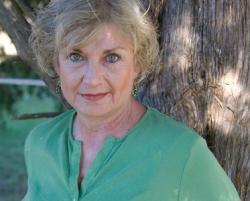 Carolyn Haines is the USA Today bestselling author of the Sarah Booth Delaney mystery series and a number of other books in mystery and crime, including the Pluto’s Snitch paranormal-historical mystery series, and Trouble, the black cat detective romantic suspense books. She is the recipient of the Harper Lee Award for Distinguished Writing, the Richard Wright Award for Literary Excellence, and the Mississippi Writers Guild Lifetime Achievement Award. She is a former journalist, bartender, photographer, farmhand, and college professor and lives on a farm where she works with rescue cats, dogs, and horses.
Carolyn Haines is the USA Today bestselling author of the Sarah Booth Delaney mystery series and a number of other books in mystery and crime, including the Pluto’s Snitch paranormal-historical mystery series, and Trouble, the black cat detective romantic suspense books. She is the recipient of the Harper Lee Award for Distinguished Writing, the Richard Wright Award for Literary Excellence, and the Mississippi Writers Guild Lifetime Achievement Award. She is a former journalist, bartender, photographer, farmhand, and college professor and lives on a farm where she works with rescue cats, dogs, and horses.

